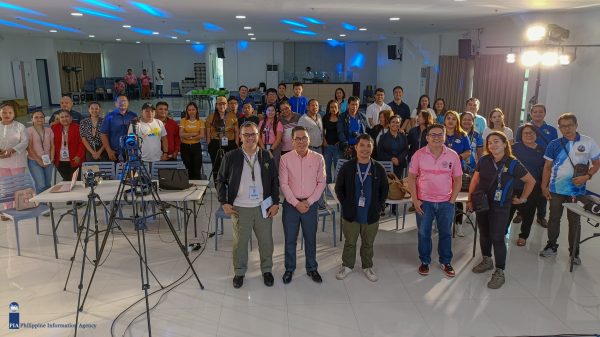MALAYBALAY CITY (PIA) — “Northern Mindanao ranks among the country’s top 5 regions in livestock production for major commodities,” said Regional Executive Director Jose Apollo Pacamalan of the Department of Agriculture (DA)-10 during the Kapihan sa Bagong Pilipinas on June 18.
He said northern Mindanao, known as Mindanao Island’s food basket, leads the way in livestock farming and ushers in a new era of agricultural growth.
“We are 1st in cattle, 3rd in carabao, hog, chicken, and goat production. In support of the genetic improvement initiatives, we successfully inseminated 5,669 animals using artificial insemination (AI) technology and distributed 10,000 semen straws to 287 group beneficiaries,” he noted with pride, listing the region’s impressive rankings.
He clarified that farmers store livestock semen in semen straws for AI breeding, using cutting-edge techniques to improve livestock quality.

Genetic innovations and AI techniques
Pacamalan emphasized the value of genetic advancement in livestock, revealing that farmers could obtain superior cattle breeds using AI technology.
DA’s two breeding programs—the Unified National Artificial Insemination Program (UNAIP) and the Philippine Native Animal Development (PNAD)—are the primary engines for their livestock improvement efforts.
Through UNAIP, DA provides advanced artificial insemination technology, enhancing the quality and productivity of livestock. The PNAD program focuses on developing and promoting native animal breeds, ensuring sustainable and resilient farming practices.
Breeder production centers
Pacamalan said the region is home to three major production centers funded and maintained by the Regional Livestock Program. These centers, located at the Northern Mindanao Agricultural Crops and Livestock Research Center (NMACLRC) in Malaybalay City, the Research Center for Upland Development (RCUD) in Dangcagan, Bukidnon, and the Research Center for Hillyland Development (RCHD) in Claveria, Misamis Oriental, are vital to the region’s agricultural advancements.
“Our breeder production centers maintain a biodiverse livestock population, including 53 cattle, 115 goats, and 27 native swine. We also raise 100 ducks, 11 carabao, 10 sheep, and 30 native chickens,” he reported, emphasizing the diversity and scale of their operations.
The DA, he said, is expanding its reach by establishing three chicken multiplier farms in Cagayan de Oro City, Camiguin, and Jasaan, Misamis Oriental, along with three cattle multiplier farms in Bukidnon and Misamis Oriental, and one duck multiplier farm in Libertad, Misamis Oriental. These facilities boost local production and ensure a steady supply of high-quality livestock.
Boosting small-holding farmers’ income
To increase small-holding farmers’ income, DA implemented the Livestock Economic Enterprise Development (LEED) program. To ensure a holistic approach, it collaborated with corn farm cooperatives to support cattle, carabao, hogs, chickens, and goats by providing feed and other resources. The LEED program offers housing, livestock, machinery, equipment, drugs, and biologics to combat Avian Flu and African Swine Fever (ASF).
Records showed that DA NorMin recently donated a P5.2 million swine production facility to the Sinuda Multi-Indigenous Sectoral Farmers and Workers Association (SIMUSOFAWA) in Kitaotao, Bukidnon. The association, active for five years with 200 members, includes a majority of 70 percent from the Matigsalog tribe.
SIMUSOFAWA chairperson Datu Domino Pangcat thanked the government for the 2,000 square-meter bio-secured swine facility featuring the perimeter fence, office, climate-controlled animal housing, a shower area, biogas waste management system, farm equipment, which also includes feeds, hog scale, animal stocks, and drugs and biologics.
“Nagpasalamat ko sa DA sa paghatag ini nga proyekto. Makatabang gyud ni sa among panginabuhian ug makadugang sa among kita. Sa pagkakaron, maniguro mi nga makaapil sa training aron molambo ug mo-asenso ang kinabuhi sa matag miyembro sa among kapunungan,” Pangcat said.
(We sincerely thank the DA for this project. It will boost our earnings and livelihoods. We are fully committed to the training, ensuring the project’s success and a better quality of life for all our members.)
The agriculture department also launched the Integrated National Swine Production Initiatives for Recovery and Expansion (INSPIRE) Program. It helped establish one unit of INSPIRE Swine Clustering and distributed 3,282 heads of swine to 1,081 individual beneficiaries in Misamis Oriental, Lanao del Norte, and Camiguin. These efforts aimed to upgrade provinces and municipalities from red to pink ASF zoning via the INSPIRE-Sentinel Protocol.
Pacamalan explained that the pink ASF zone indicates a transition out of high-risk status but still calls for constant monitoring and control measures to ensure the disease does not reemerge. In contrast, the red ASF zone points to areas with confirmed outbreaks or a high risk of infection.
Feeds and forage development
The Feed and Feed-Based Development Program also helps maintain livestock health and productivity.
The DA distributed 160 kilos of forage seeds and 5,000 pieces of forage planting materials (including alemengia, ensonii, centrosema, and ipil-ipil) to 15 farmer groups and 100 individuals. The Crop and Livestock Integration initiative in Misamis Occidental and Bukidnon also established two village-type feed mills with multi-crop drying pavement, complete with a feed mixer and feed pellet mill.
Through these comprehensive and multifaceted programs, the DA has not only improved the lives of livestock farmers but also fortified the agricultural landscape of Northern Mindanao, solidifying its status as Mindanao island’s food basket. (RLRB/PIA-10/Bukidnon)












